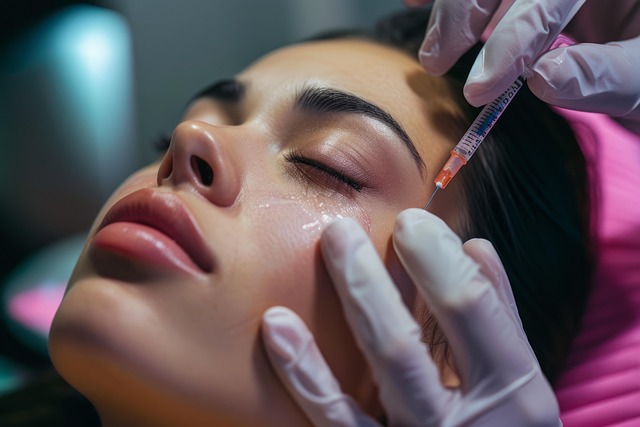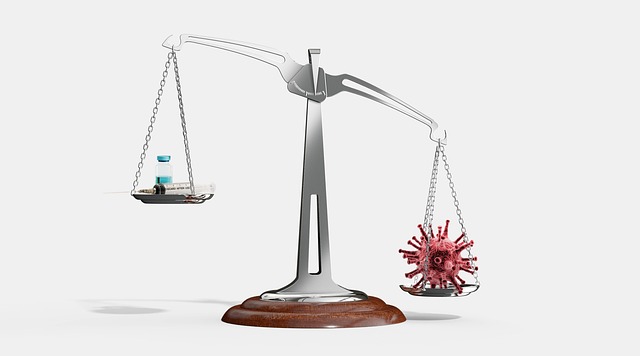Botox and dermal fillers are popular cosmetic treatments with distinct purposes. Botox, a neurotoxin derived from bacteria, relaxes muscles and prevents dynamic wrinkles by blocking nerve signals causing muscle contraction, particularly around the eyes and forehead. Dermal fillers, containing hyaluronic acid, add volume and improve facial contours by filling in hollows and enhancing static wrinkles, providing immediate results. The choice between them depends on individual needs: Botox for prevention and dermal fillers for enhancement. Preventative Botox treatments offer a strategic advantage for professionals aiming to preserve youthfulness, focusing on long-term muscle relaxation and skin smoothing. Unlike dermal fillers' immediate volumization, Botox lasts 3-6 months, requiring regular treatments every 3-4 months. Proper post-care is crucial for both, with gentle moisturizers, avoiding harsh cleansers or facial strain, and staying hydrated.
“Unwind the secrets of youthful skin with an in-depth exploration of professional preventative Botox care. This comprehensive guide delves into the world of aesthetic treatments, shedding light on the nuances of Botox and its contrasting counterpart, dermal fillers. Discover how proactive Botox treatments can benefit professionals, offering more than just cosmetic enhancement. From understanding the science behind this powerful neurotoxin to choosing tailored treatment plans, we navigate the journey towards a smooth, natural-looking revival. Learn about post-treatment care and the long-term effects that ensure a lasting youthful appearance.”
Understanding Botox and Dermal Fillers: Unveiling the Differences

Botox and dermal fillers are both popular cosmetic treatments, but they serve different purposes. Botox, a neurotoxin derived from bacteria, is primarily used to relax muscles and prevent dynamic wrinkles, especially around the eyes and forehead. It works by blocking nerve signals that cause muscle contraction, resulting in smoother skin.
Dermal fillers, on the other hand, are hyaluronic acid-based substances injected into the skin to add volume and improve facial contours. They enhance static wrinkles and provide immediate results. Unlike Botox, dermal fillers do not require muscle relaxation; instead, they fill in hollows and add definition to the face, giving a more youthful appearance. The choice between Botox vs. dermal fillers depends on individual needs and goals, with Botox focusing on preventing dynamic wrinkles and dermal fillers enhancing existing static lines.
Benefits of Preventative Botox Treatments for Professionals

Preventative Botox treatments offer a range of benefits for professionals looking to maintain and enhance their appearance. Unlike dermal fillers, which often focus on instant results, Botox prioritises long-term muscle relaxation and skin smoothing. This approach not only reduces the appearance of fine lines and wrinkles but also prevents their formation by relaxing facial muscles that contribute to dynamic wrinkling.
For professionals who spend significant time in front of screens or engage in demanding careers, these treatments can be a game-changer. By addressing potential signs of aging proactively, individuals can maintain a youthful glow and confident demeanor. Additionally, preventative care aligns with a holistic wellness approach, fostering a sense of well-being that extends beyond external aesthetics.
The Science Behind Botox: How It Works and Its Safety Profile

Botox, a neurotoxin derived from the bacteria Clostridium botulinum, has gained popularity as a preventative skincare treatment. Its mechanism of action involves blocking specific nerves that stimulate muscle contraction, leading to temporary relaxation of the treated muscles. This results in reduced appearance of fine lines and wrinkles, especially around the eyes and forehead – areas where dynamic facial expressions cause repeated muscle contractions.
When compared to dermal fillers, which add volume and enhance facial contours, Botox offers a more targeted approach. It’s particularly effective for individuals seeking to prevent or minimize the formation of dynamic wrinkles. The safety profile of Botox is well-established, with minimal side effects when administered by qualified professionals. Common temporary side effects may include slight bruising, swelling, or discomfort at the injection sites, but these usually resolve within a few days. Regular, preventative treatments can help maintain youthful-looking skin and provide a more subtle, natural result compared to dermal fillers.
Choosing the Right Treatment Plan: Individualized Approach for Optimal Results

When considering preventative Botox care, it’s crucial to understand that one-size-fits-all approach doesn’t exist. Each individual has unique facial dynamics and goals, so a personalized treatment plan is essential for optimal results. This individualized approach starts with a comprehensive consultation where your provider assesses factors like muscle tone, skin quality, age, lifestyle, and specific concerns.
Unlike Botox vs dermal fillers, which often have broader applications, preventative Botox focuses on non-invasive muscle relaxation to prevent the formation of dynamic wrinkles. The treatment plan is tailored to target specific areas, addressing early signs of aging while promoting a natural appearance. This personalized touch ensures that the results align perfectly with your desired aesthetic and longevity goals.
Post-Treatment Care and Recovery: Tips for a Smooth Experience

After your Botox or dermal filler treatment, proper post-care is essential for optimal results and a smooth recovery. Here are some tips to ensure a positive experience:
Keep your face clean and gently moisturized. Avoid using harsh cleansers or any products that may irritate the skin. Both Botox and dermal fillers require careful handling, so it’s crucial not to massage or rub the treated area. Instead, apply a mild moisturizer as recommended by your healthcare provider. Staying hydrated will help reduce swelling and provide a healthier complexion. Remember, direct sunlight can impact healing, so use sunscreen when outdoors to protect your skin from UV damage, especially in the initial post-treatment days.
Avoid certain activities that may cause facial strain or pressure. For instance, resist the urge to blow your nose vigorously, smile excessively, or engage in intense physical exercises right after the procedure. These actions could potentially disrupt the treatment’s effects or even lead to complications with dermal fillers. Be patient and allow sufficient time for your body to heal before resuming these activities. If you experience any discomfort, mild swelling, or bruising, which are common post-treatment, applying a cold compress can provide relief.
Long-term Effects and Maintenance: Ensuring Lasting Youthful Appearance

Botox has established itself as a leading choice for anti-aging treatments, offering a natural and effective way to reduce fine lines and wrinkles. However, achieving long-term results requires ongoing care. Unlike dermal fillers that provide immediate yet temporary enhancement, Botox’s effects develop over time, typically lasting between 3-6 months. To maintain a youthful appearance, regular treatments are essential, ensuring the prevention of new lines forming while also addressing existing ones.
In terms of maintenance compared to Botox vs Dermal Fillers, Botox care requires a more consistent commitment. While dermal fillers can be topped up every 6-12 months, Botox effects demand a more frequent schedule, usually every 3-4 months. This continuous care is crucial for sustaining the desired results and keeping pace with natural aging processes.
